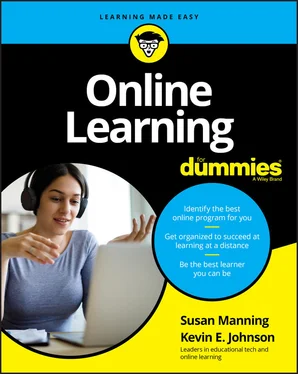Education Planner: See its inventory at www.educationplanner.org/students/self-assessments/learning-styles-quiz.shtml
Vark: It’s at https://vark-learn.com/the-vark-questionnaire .
People who prefer to learn visually like to read and look at images. They like to work with words that are on a page. In the online environment, visual learners prefer to read content or articles, look at charts and images, and take in information through their eyes. The page may be either a real textbook or a computer screen. For the record, most people are visual learners.
 If you like to access information visually, you will do well with reading requirements. If you don’t find enough graphics or images to help you learn, ask your instructor whether they know of alternatives. Sometimes textbooks come with corresponding websites that offer PowerPoint presentations and other supporting materials.
If you like to access information visually, you will do well with reading requirements. If you don’t find enough graphics or images to help you learn, ask your instructor whether they know of alternatives. Sometimes textbooks come with corresponding websites that offer PowerPoint presentations and other supporting materials.
Auditory learners prefer to hear information, and their brains process the sounds. Have you ever met someone who listens attentively to you but never takes notes and still remembers what you have told them? Chances are, that person is an auditory learner. Their ears take in the information and the brain stores and processes it. Auditory learners love to hear stories, by the way. In an online course, auditory learners immediately gravitate toward programs with sound, such as slides with narration or videos.
Those who are auditory learners may struggle a little with the text-heavy nature of many courses. However, these days more faculty are including podcasts and audio files as well as video introductions as part of their courses. They also may narrate PowerPoint presentations to help auditory learners better understand the material.
 Need a couple of strategies for working with an auditory preference? Read out loud to yourself. When you read your classmates’ posts, give them each a separate “voice.”
Need a couple of strategies for working with an auditory preference? Read out loud to yourself. When you read your classmates’ posts, give them each a separate “voice.”
 Don’t be afraid to look for additional materials on your own. Can’t quite understand Newton’s third law? You’d be surprised what you can find on YouTube, such as materials that are prepared for middle school kids but still make sense and entertain at the same time.
Don’t be afraid to look for additional materials on your own. Can’t quite understand Newton’s third law? You’d be surprised what you can find on YouTube, such as materials that are prepared for middle school kids but still make sense and entertain at the same time.
Tactile or kinesthetic learners
Perhaps you’re best described as someone who likes to take action before reading the instructions or listening to directions. If so, you may be a tactile or kinesthetic learner! People who are kinesthetic like to put their bodies into motion in order to learn. It’s too simplistic to say that this means the individual has to move in order to take in or process information, but when opportunities allow that person to put new ideas into practice, learning becomes easier. Say you want to learn a concept related to chemistry. You may read about it or listen to a lecture, but once you begin to experiment, it makes more sense. It’s the action of doing that helps embed that new information.
 Clicking a computer mouse doesn’t count as movement. However, regardless of when or where you’re working, you can stand up and walk around, eat while you work, take frequent breaks, and otherwise keep your fidgeting and movement going while you work.
Clicking a computer mouse doesn’t count as movement. However, regardless of when or where you’re working, you can stand up and walk around, eat while you work, take frequent breaks, and otherwise keep your fidgeting and movement going while you work.
Being patient and tolerant
Seldom are we told that patience and tolerance are necessary qualities for academic survival. However, the classroom has gone global, and technology is now a factor. In the following sections, we describe the facets of online learning that require your patience and tolerance.
 Online learning differs from traditional schooling in many ways. It’s the 21st century method of acquiring information, putting it into practice, and interacting with other learners. Having some doubts is natural, but only if you enter the virtual classroom with a sense of wonder and possibility will you truly learn.
Online learning differs from traditional schooling in many ways. It’s the 21st century method of acquiring information, putting it into practice, and interacting with other learners. Having some doubts is natural, but only if you enter the virtual classroom with a sense of wonder and possibility will you truly learn.
Trying new learning methods and technologies
Online learning stretches most learners. Many of the procedures and processes feel awkward, and the instructor may throw in new technology tools. How well you adapt to these additional challenges can make a difference in your overall survival online. The following short list describes some of the tools or methods you may face online (see Chapter 3for more details on technology and the technological skills you need):
Group work: Very common online. Instructors pair up students or assign them to small discussion groups to work out problems.
Wiki: A web page that different people can edit. It’s a simple tool that is used in group work. If you can edit a Word document, you can handle a wiki.
Blog: A web page that you may use in two different ways. You may just be asked to go to a blog and read the entries. Or, you may be asked to keep a blog — kind of like a public journal — of what you experience in the class.
Webinar: A live session where you can hear a presenter and see images. Instructors who have live office hours often use similar software.
Chat: Instant communication when you need to ask a question or work out a group decision.
Podcasts: Audio files that you can download and play on your computer or on your portable MP3 device.
Recognizing different kinds of people in the classroom
Cast your mind back to your glory days in high school. Chances are good that someone in your classes was a know-it-all. There may have been a teacher’s pet. And how about a class clown? Guess what? They’ve moved online.
If you were particularly annoyed with a certain personality type when in a traditional class, you should prepare to meet the same person online. This time, however, you’ll recognize their characteristics via writing behaviors. The know-it-all will answer everyone else’s posts with an American Psychological Association (APA)-formatted reference. The teacher’s pet will suck up with glowing acknowledgments of the teacher’s presence. The class clown will always have a pun.
 There are probably many more ways to describe people. Suffice it to say that this is where tolerance comes back into play. It’s important to get along when online, refrain from engaging in hurtful communication, and focus on your own work — not everyone else’s. Check out Chapters 9, 10, and 11for plenty of pointers on working well with others online.
There are probably many more ways to describe people. Suffice it to say that this is where tolerance comes back into play. It’s important to get along when online, refrain from engaging in hurtful communication, and focus on your own work — not everyone else’s. Check out Chapters 9, 10, and 11for plenty of pointers on working well with others online.
Counting to ten when you’re upset
 When something doesn’t go your way in the online classroom, count to ten before reacting. If you read a comment that seems unkind or downright mean, don’t blast off a nasty response. We say much more about netiquette in Chapter 15, but the bottom line is that you need to write civilly in the online world. Emotions are often incorrectly “read” into written communication, and this causes definite problems.
When something doesn’t go your way in the online classroom, count to ten before reacting. If you read a comment that seems unkind or downright mean, don’t blast off a nasty response. We say much more about netiquette in Chapter 15, but the bottom line is that you need to write civilly in the online world. Emotions are often incorrectly “read” into written communication, and this causes definite problems.
Читать дальше

 If you like to access information visually, you will do well with reading requirements. If you don’t find enough graphics or images to help you learn, ask your instructor whether they know of alternatives. Sometimes textbooks come with corresponding websites that offer PowerPoint presentations and other supporting materials.
If you like to access information visually, you will do well with reading requirements. If you don’t find enough graphics or images to help you learn, ask your instructor whether they know of alternatives. Sometimes textbooks come with corresponding websites that offer PowerPoint presentations and other supporting materials. Online learning differs from traditional schooling in many ways. It’s the 21st century method of acquiring information, putting it into practice, and interacting with other learners. Having some doubts is natural, but only if you enter the virtual classroom with a sense of wonder and possibility will you truly learn.
Online learning differs from traditional schooling in many ways. It’s the 21st century method of acquiring information, putting it into practice, and interacting with other learners. Having some doubts is natural, but only if you enter the virtual classroom with a sense of wonder and possibility will you truly learn.










